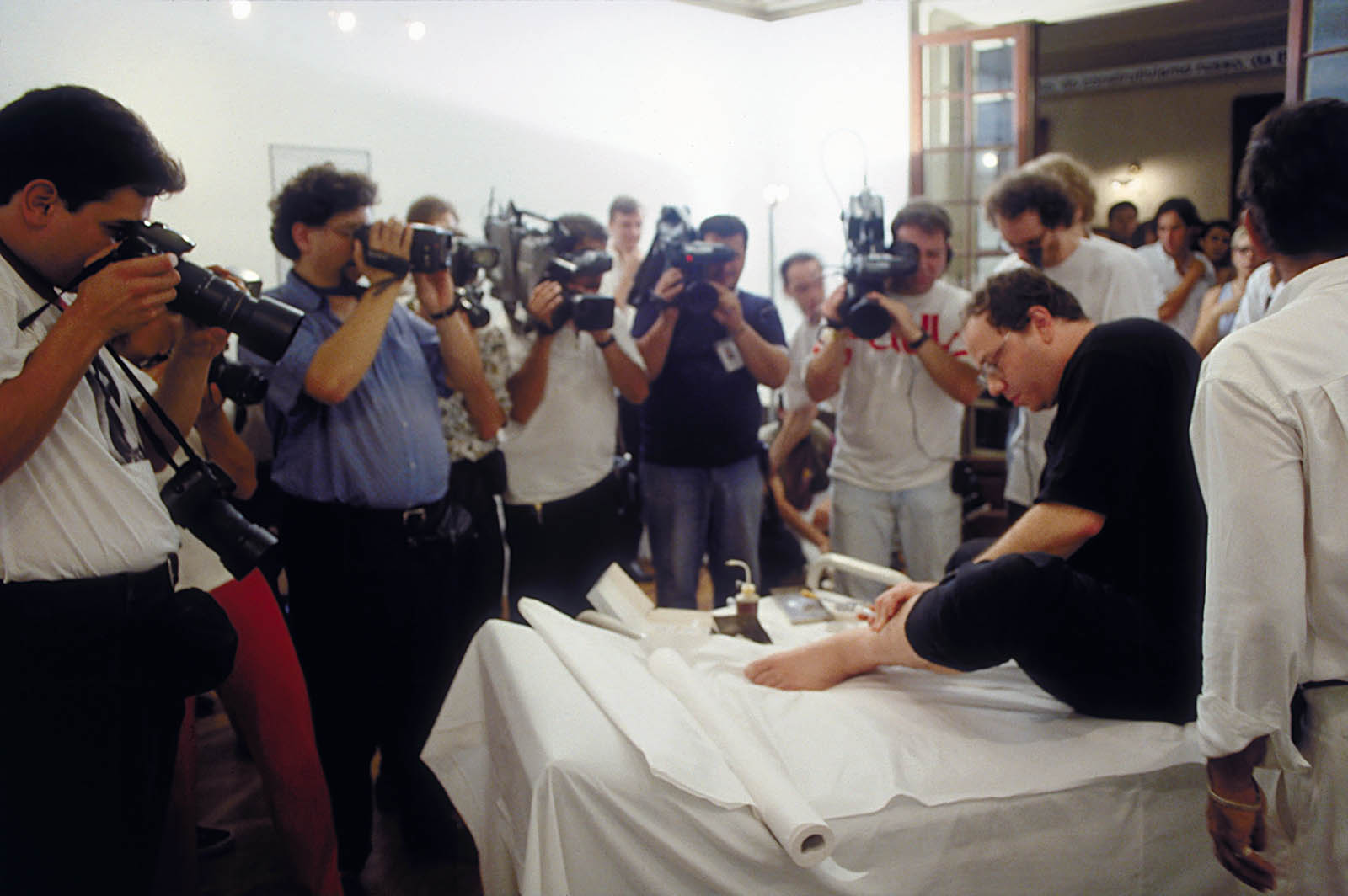Week 4: Medicine + Technology + Art
"Time Capsule" by Edwardo Kac remains a groundbreaking exploration of the convergence of art, medicine, and technology, challenging traditional understandings of identity and embodiment. Kac's installation blurs the boundaries between technology and art, presenting a thought-provoking analysis of the evolution of humans and digital culture.
At its core, "Time Capsule" revolves around the implantation of a microchip, that is typically used for animals into Kac's own body (Herrera). This act serves as a symbolic gesture highlighting the growing intimate emergence of technology into the human experience. By registering himself into a database originally designed for animals, Kac prompts introspection into the shifting boundaries of the future of technology. Kac was beyond his time with this installation and gives a "preamble of what is to come" in the future (Vesna).

As I researched more on Kac, I found that he conducted another conceptual art performance that became his most famous yet contentious piece of work. While the piece was left with various interpretations of animal cruelty, Kac states "'This must be done with great care, with acknowledgment of the complex issues thus raised and, above all, with a commitment to respect, nurture, and love the life thus created'" (Kac). Central to the project was a rabbit named Alba who was genetically modified to produce the green fluorescent protein sourced from a jellyfish. GFP was a common gadget used for cellular research, "...cells of a certain type could be engineered to express the protein and thus be more easily visible" (Pallardy). Throughout the research, Kac found that only the living tissue emits the green glow of GFP under blue light, thus leaving the fur unaffected. In all, through this experiment, Kac blurs the lines between nature and technology, challenging audiences to reconsider their relationship with the natural world and genetic manipulation.
In all, Kac sets the stage for what is to come for humans and animals in light of growing technological advancements. He highlights the thought-provoking intersection between medicine, technology, and art. It truly is fascinating to think about how technology is both going to help and disadvantage humans in the future. It will be so interesting to investigate how technology will "...enhance and exceed our current capabilities" (Modesta).
Works Cited
Hoyt, Dale. Google Search, Google, www.google.com/search?sca_esv=619c697d276fe56b&q=kac%2Balba&uds=AMwkrPvgX8tMiCETaNelXKa7O7lJBsdgRWcB-2I5IfmIWbeWyvW_zCgfrPKkiRI28yXNZ5Ets4gjMP1lB-1OXfNK_32low-uKH-P_exE27l-d2l9E_Nb5jTsjihhi1Z44T3Kz66QPQ-_jSeKPSmEnl30bNEF_SRg7pAgBPDwGm_GH2gcYZ5iTnLGjNAMajynMzo_4tcvPiKQ_SEQxRyI-FkQV3gzqT7-EX8aL9og57Qo-xvgGtlT-vJIavTJKm5tSqTblwatrst8BjGIo6sOIKwVxF6Fcz9mUM45MUKwGVJdkXh81MPsHHXWE9zo-9GZoF9DjwqN3yat&udm=2&prmd=isvnmbtz&sa=X&ved=2ahUKEwjeoJq1yNuFAxUjJEQIHadDB1EQtKgLegQIChAB&biw=1440&bih=779&dpr=2#vhid=2lgDm6K58VWLLM&vssid=mosaic. Accessed 24 Apr. 2024.
Herrera, Stephan. “Profile: Eduardo Kac.” Nature News, Nature Publishing Group, 1 Nov. 2005, www.nature.com/articles/nbt1105-1331.
Kac, Eduardo. Bio Art: From Genesis to Natural History of the Enigma, www.ekac.org/bioart_kac.pdf. Accessed 24 Apr. 2024.
Modesta, Viktoria, et al. “Designing Our Bodies for the Future.” CNN, Cable News Network, 3 Mar. 2020, www.cnn.com/style/article/designing-bodies-future/index.html.
Pallardy, Richard. "Eduardo Kac". Encyclopedia Britannica, 29 Jun. 2023, https://www.britannica.com/biography/Eduardo-Kac. Accessed 24 April 2024.
Time Capsule, www.ekac.org/timcap.html. Accessed 24 Apr. 2024.
Vesna, Victoria. "Lecture 4."

Hi Mallory! I found your blog post very interesting, and as I was reading I was thinking about whether genetically modified organisms could be considered art. If you think about it, they are carefully created with meaning. I think they would be considered art when looking at most definitions of art. However, you really wouldn't think about genetically modified organisms as art, so I think this is very interesting.
ReplyDeleteHi Mallory! I found your point about genetic manipulation extremely fascinating as it showcases the combination of art and science very apparently. Science is oftentimes changed in a way for experiments to demonstrate certain colors and forms for the scientist to better understand their work. In this case, the green light in regards to the jellyfish sourcing really highlights the importance of using both science and art. Also, I loved the image of the rabbit!
ReplyDelete